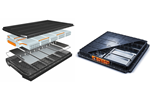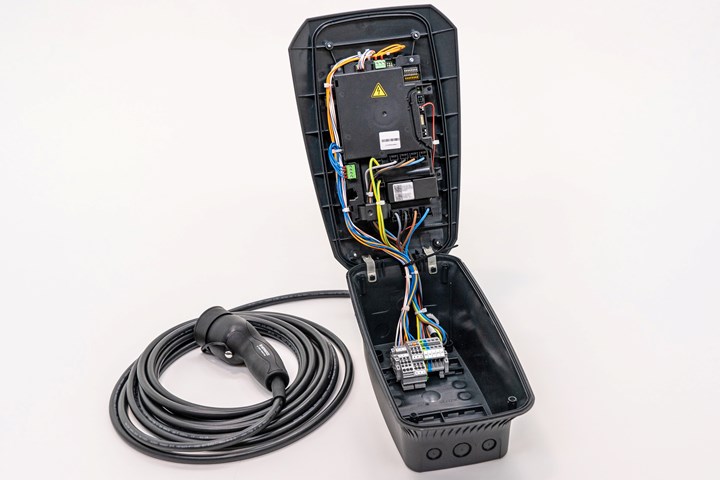Lanxess composite advances electric vehicle charging infrastructure
Halogen-free glass fiber-reinforced Durethan BKV20FN01 was used in the manufacture of charging cable connectors, demonstrates high tracking resistance and flame retardance.
The charging cable connectors (colorful internal wires) made of the halogen-free flame-retardant, fiberglass-reinforced PA6, Durethan BKV20FN01, are used in Kostal’s own Enector wallboxes, which are distributed via Kostal Solar Electric. Photo Credit: Lanxess
According to Lanxess (Cologne, Germany) in addition to their use in battery and electric powertrain applications, technical plastics like fiber-reinforced composites have application potential for electric vehicle (EV) charging infrastructure, particularly wall-mounted charging stations. Used inside buildings such as parking garages or private garages, and with a strict selection criteria for materials, Lanxess says its halogen-free, flame-retardant glass fiber-reinforced Durethan BKV20FN01 can meet such high requirements.
In one instance, Lanxess used the polyamide 6 (PA6) compound to make charging cable connectors manufactured by Leopold Kostal GmbH & Co. KG (Lüdenscheid, Germany), a global system supplier of automotive, industrial and solar electrics as well as electrical contact systems. The charging cable connectors are used in Kostal’s Enector wallboxes, which are distributed via Kostal Solar Electric, as well as in wallboxes from a German producer of industrial connector systems and charging solutions for electromobility.
“The key arguments for using our material in this application were its high tracking resistance and high flame retardance based on the halogen-free flame retardant package. It is also easy to process and produces components with a high surface quality,” Dr. Bernhard Helbich, technical marketing manager, Key Accounts, at Lanxess, says.
Durethan BKV20FN01’s level of flame retardance is demonstrated by the US Underwriters Laboratories UL 94 flammability test. The polyamide passes the test with the top classification of V-0 at a test specimen thickness of 0.75 millimeters, Lanxess says. Because wallboxes come under “unattended household appliances,” the plastics used must comply with the international standard IEC/EN 60335-1. In particular, they must prove that they are flame retardant in glow-wire testing. Durethan BKV20FN01 passes the GWIT test (Glow Wire Ignition Temperature, IEC 60695-2-13) at 775°C with test specimen thicknesses of 0.75 millimeter and above. In the GWFI test (Glow Wire Flammability Index, IEC 60695-2-12), the thermoplastic reportedly achieves the top value for plastics of 960°C (0.75 millimeter test specimen thickness).
Lanxess notes that another strength of the material is its high tracking resistance. For example, it achieves the top rating of 600 in the CTI A test (Comparative Tracking Index, IEC 60112) and the top value of PLC 0 (Performance Level Category) in the similarly designed UL 746 test.
“This reduces the risk of short circuits and defects caused by creepage currents in the wallbox. In addition, the electrical and electronic assemblies can be designed more compactly, resulting in a smaller device overall with higher power density,” Helbich explains.
The compound, which is reinforced with 18% short glass fibers by weight, also has good strength, stiffness and toughness. The charging cable connector systems are therefore not susceptible to mechanical loads, particularly during assembly. The polyamide can also be economically processed in a stable injection molding process.
Related Content
-
Cryo-compressed hydrogen, the best solution for storage and refueling stations?
Cryomotive’s CRYOGAS solution claims the highest storage density, lowest refueling cost and widest operating range without H2 losses while using one-fifth the carbon fiber required in compressed gas tanks.
-
Jeep all-composite roof receivers achieve steel performance at low mass
Ultrashort carbon fiber/PPA replaces steel on rooftop brackets to hold Jeep soft tops, hardtops.
-
Carbon fiber, bionic design achieve peak performance in race-ready production vehicle
Porsche worked with Action Composites to design and manufacture an innovative carbon fiber safety cage option to lightweight one of its series race vehicles, built in a one-shot compression molding process.
















